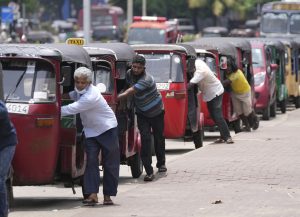On April 12, Sri Lanka announced that it was suspending external debt repayment and seeking a consensual restructuring of these obligations “in a manner consistent with an economic adjustment program supported by the IMF.” This is Sri Lanka’s first sovereign default.
The decision does not come as a surprise as Sri Lanka’s post-pandemic economic recovery has been slow. The situation has been made worse by mismanaged government finances and ill-timed tax cuts. Foreign reserves were at historic lows, major debt repayment is coming up, and the Sri Lankan currency is in a free fall, depreciating close to 65 percent since the restrictions on exchange were relaxed in early March.
Food and fuel shortages, power cuts, and inadequate supply of medicines, among other items, have become a daily occurrence in the country.
Two weeks later, and several rounds of discussions between Sri Lankan and IMF officials in Colombo and in Washington, the two sides have begun a process to finalize the securing of a Rapid Financing Instrument and an Extended Fund Facility.
Anne-Marie Gulde-Wolf, acting director of the IMF’s Asia and Pacific Department, said on April 26 that Sri Lanka must tighten monetary policy, raise taxes, and adopt flexible exchange rates to address its debt crisis.
Even before defaulting, Sri Lanka had floated the rupee and following the ascension of Dr. Nandalal Weerasinghe as the governor of the Central Bank, had tightened its monetary policy. It has also increased petrol and diesel prices to reflect market prices.
Following the discussions Sri Lankan officials had with the IMF in Washington between April 18 and 22, the Sri Lankan government is expected to submit a Letter of Intent to the IMF, outlining the country’s roadmap toward economic stability.
Since opening the economy in 1977, the gap between Sri Lanka’s exports and imports has been growing. The gap has been filled for the most part through foreign loans, which must be repaid in hard currencies.
Given that the gap between exports and imports continued to widen, successive governments depended on remittances and tourism for foreign exchange, and turned to foreign loans to repay debt and pay for imports. Since 2007, Sri Lanka has depended on international capital markets through issuing International Sovereign Bonds (ISBs) for loans, but this had to be stopped in 2019 due to the country’s rapidly falling credit ratings after President Gotabaya Rajapaksa took recourse to ill-advised tax cuts, which reduced the government income by a quarter.
The severe blows to tourism following the Easter Sunday terror attacks and drastically reduced worker remittances, due to artificially keeping the exchange rates low and the lack of faith in the government, contributed to Sri Lanka not being able to pay for imports and debt repayments.
Debt restructuring usually means a loss for the creditors, as they often need to take what is called a “haircut.” Moreover, they need to be reassured that they will receive the money a country owes them. A country like Sri Lanka, small and with a proven track record of mismanaging public finances, can only give such guarantees by entering a program with the IMF.
Usually when a country enters a program with the IMF, it must adhere to certain conditions. Such conditions often include changes to the tax regime, reduction of government expenditure, and introduction of a fuel and utilities pricing formula that reflects market prices.
While Sri Lankans in principle agree that the government needs to change the way it operates and that there is a need for economic reforms, there is little consensus over what needs to be done.
Sri Lanka had sent Letters of Intent to the IMF 2009 and 2016 promising a number of adjustments ranging from changing the tax regime to introducing pricing formulas for fuel and electricity. Almost none of them were implemented. Governments have been hesitant to fully implement the promises given to IMF because they come with steep social and political costs.
As mentioned earlier in the article, Sri Lanka has floated the rupee, tightened its monetary policy by raising interest rates, and removed any controls over the prices of most products, from fuel to soap. Despite fuel prices almost doubling from February, it is estimated that the price of a liter of diesel must be further increased by 75 Sri Lankan rupees ($0.21) and the price of petrol by 15 rupees. Kerosene, which is currently sold at 87 rupees per liter, must be increased to 300 rupees to reflect market prices.
As critics of the IMF policies point out, these policies disproportionately affect the poor and would exert major pressures on the middle class. In his article “Why the IMF is bad for Sri Lanka, in 7 points,” Indi Samarajiva lists out the most common criticisms against the recommendations that the IMF usually makes. IMF recommendations like removing price controls, depreciating the currency, trade liberalization, privatization, etc., would be “wildly unpopular and not democratically approved,” he says.
Umesh Moramudali, a leading Sri Lankan researcher on debt, told The Diplomat that in a year the current crisis in Sri Lanka will be known as the “IMF Crisis.” This is similar to how the 1997 financial crisis in South Korea came to be known as the “IMF crisis.”
Most of the IMF policies that the Sri Lankan government will implement are likely to be resented by the Sri Lankan poor and the middle classes and are sure to be opposed by Sri Lanka’s opposition parties and trade unions. This will make it difficult for the Rajapaksa government to implement the IMF recommendations, especially in the context of the government’s immense unpopularity already.
However, the government cannot keep the economy running without IMF support.
If the Rajapaksa government survives the current political turmoil, it has a number of tough choices to make.

































